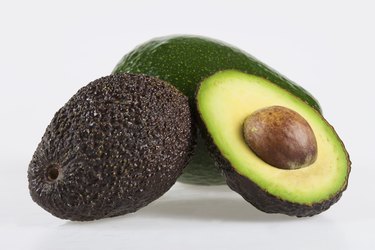
Food spoilage is a rapid and inevitable process when you don't take adequate preventative measures. Microscopic organisms feast on food items that you leave unattended. Several traditional and modern techniques allow for long-term food preservation. While nothing can preserve food forever, these techniques offer the chance to keep foods well past their time of production.
Bacteria
Video of the Day
Microscopic bacteria cause food to spoil. These tiny organisms, called spoilage bacteria, consume unprotected foods and produce waste products. As long as nutrition and water are present, bacteria will multiply, sometimes rapidly. Bacterial waste is the cause of the foul smell and rotten appearance of spoiled food. Surprisingly, rotten food will not necessarily cause illness if consumed. Instead, other bacteria species called pathogenic bacteria are the cause of foodborne illnesses like salmonella and E. coli. It's possible for food to look and smell safe, but still contain dangerous levels of pathogenic bacteria.
Video of the Day
Incorrect Storage
Improper food storage is a leading cause of spoilage. If your house is warm and humid, fruits and veggies left in the open will spoil quickly. A refrigerator temperature above 40 F allows for the growth of spoilage bacteria. Food items should be stored separately in tightly sealed containers. Designate one drawer for meats, one for cheeses and one for vegetables. Check your refrigerator foods every day. If one food starts to spoil, remove it immediately. The spoilage bacteria may spread from the bad food and contaminate everything else.
Refrigeration and Freezing
Refrigerators set below 40 F will prevent pathogenic bacteria from growing freely. However, refrigerators generally aren't cold enough to stop all bacterial growth. Monitor foods for signs of spoilage, especially meats. Freezers are ideal for long-term storage. To properly store foods in the freezer, remove as much air as possible from the container. Ensure that the temperature is set at or below 0 F. If you experience a power outage, leave refrigerator and freezer doors closed. An external thermometer will let you keep tabs on the fridge or freezer temperatures without opening the doors.
Dehydration
Bacteria need moisture, oxygen and the proper temperature range in order to multiply. Dehydration is the process of removing moisture from foods, thereby slowing or stopping the growth of spoilage bacteria. To dehydrate food properly, you need low humidity and a source of heat. You can use a conventional oven set to warm with the door open or an actual food dehydrator. The food needs to be heated to about 140 F. Dry, circulating air helps draw moisture out of the food. Dehydration also makes foods lighter, smaller and easier to store and transport.
Canning
You can preserve high-acid foods using a traditional process called canning. Apples, berries, peaches and tomatoes are just a few foods that may be canned safely. Boiling water kills spoilage bacteria and creates a vacuum seal around the jar lid. Canned food items must be cooked for a minimum amount of time to ensure that all bacteria are killed. Botulism, a deadly bacterial toxin, grows quickly in canned goods that have been improperly processed. The Virginia Cooperative Extension Office recommends closed-kettle boiling with heat-tempered jars and lids.
- United States Department of Agriculture; Food Safety and Inspection Service; Food Safety: Bacteria, Spoilage
- United States Department of Agriculture; Food Safety and Inspection Servce; Refrigeration and Food Safety
- United States Food and Drug Administration: Fresh and Frozen Seafood: Selecting and Serving It Safely
- United States Department of Veterans Affairs: Safety Tips That Help You Avoid Foodborne Illness
- Virginia Cooperative Extension: Using Dehydration to Preserve Fruits, Vegetables and Meats
- Virginia Cooperative Extension: Boiling Water Bath Canning - Including Jams, Jellies and Pickled Products
- University of Georgia: National Center for Home Food Preservation